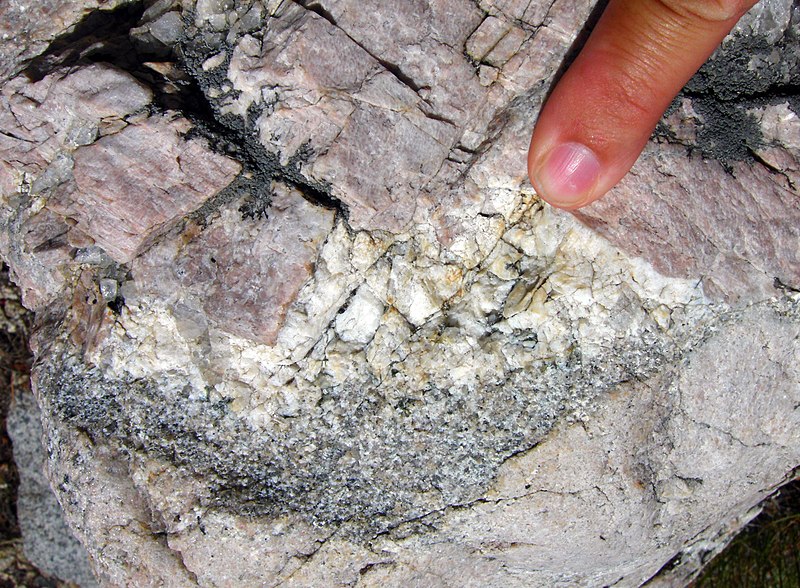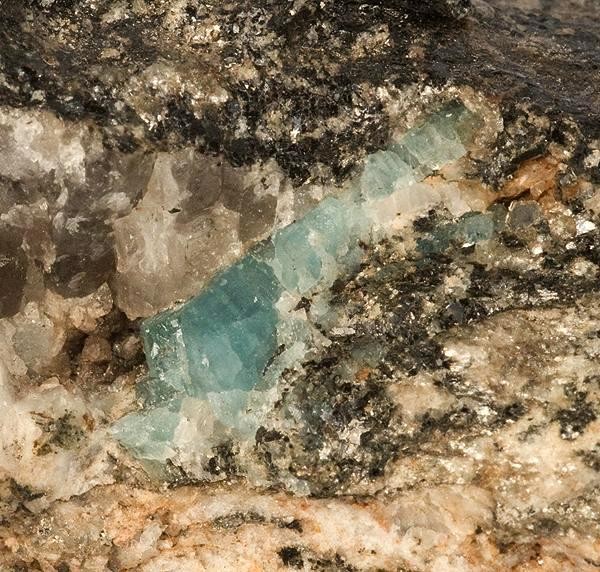 |
| Beryl crystals on schorl from a vug in a pegmatite Photo by Rob Laninsky |
As can be seen from the list if gemstones found in pegmatites most of them come from LCT pegmatites. The major components of these pegmatites beside the usual feldspar, quartz and mica are Lithium, Cesium and Tantalum hence LCT pegmatites. The three primary pegmatites grade into each other according to depth and pressure. The simple pegmatite is the closest to the body of intrusive granite having the highest pressure and temperature. As the temperature and pressure decreases the simple pegmatite grades into the LCT pegmatite, and finally grades into a NYF pegmatite. The NYF pegmatite contains the elements neodymium, yttrium and fluorine hence its name NYF.
The simple pegmatite does not contain miarolitic cavities usually, but as the pegmatite grades into the LCT phase the cavities become more prevalent, and in a NYF pegmatite they are quite common. It is in these cavities where the gems form usually as flawless crystals under the right conditions. It is estimated that only about 10% of these cavities produce flawless gems. These cavities are usually termed “vugs” when they are inside a pegmatite.
 |
| Topaz crystal on quartz from a pegmatite Photo by Rob Lavinsky |
If the vug is cracked or broken by earth movements it will lose its pressure causing the crystals to shatter so they are found as fragments on the floor of the vug. Another common feature of vugs is allowing more hydrothermal fluid to enter causing this additional fluid to etch the minerals present, and sometimes completely removing them. A late stage in the formation of a vug is the production of clay that coats the crystals with a thin layer. Unless the integrity of the vug has been breached this clay layer is composed of leftovers from the process of pegmatization. If the vug has been breached the clay is clay that has been washed into the pegmatite from surface sources. In either case the clay is usually kaolin.
 |
| Red tourmaline crystals with quartz and lipidolite on calcite Photo by Rob Lavinsky |
Even though the gem forming minerals are located in vugs in the center zone of the pegmatite the same minerals forming the pegmatite are found locked within the body of the pegmatite in this case the stones contain so many imperfections and fractures to render them useless as gems for the most part. These minerals can include many of those used as gems, but in this case they can be used as ores for several important metals such as lithium, cesium and niobium and tantalum.
Most of the LCT pegmatites display zoning with each zone carrying a specific suite of minerals. Some of these pegmatites can have as many as seven different zones. The center zone is composed mainly of quartz, and is also the zone containing the vugs.
The gem containing vugs can range in size from a few centimeters to the size of a large room. Some of these large vugs can contain several million dollars worth of gemstones as some of the monsters in the Pala district of southern California Newry , Maine Afghanistan Pakistan






